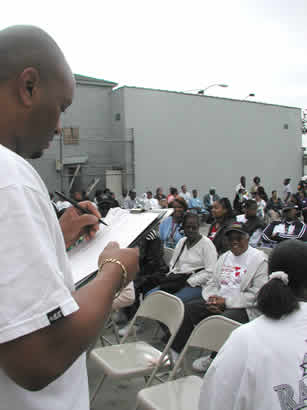 |
 |
 There are four primary goals of field organizing: to make repeated contact with voters for registration and ID, to engage voters in the electoral process, to make the most efficient use of the project’s greatest resource, its volunteers, and finally, to turn out targeted voters on Election Day. When it’s done well, each round of voter contact builds upon the last, drawing new volunteers into the work and becoming a powerful force that culminates in the GOTV long weekend. Anthony Thigpenn describes just such a campaign in the video.
There are four primary goals of field organizing: to make repeated contact with voters for registration and ID, to engage voters in the electoral process, to make the most efficient use of the project’s greatest resource, its volunteers, and finally, to turn out targeted voters on Election Day. When it’s done well, each round of voter contact builds upon the last, drawing new volunteers into the work and becoming a powerful force that culminates in the GOTV long weekend. Anthony Thigpenn describes just such a campaign in the video.
The time that field organizers spend on the sidewalks of a community, going from house to house, or on the phone, working their way down lists of voters, or manning makeshift voter registration booths at the local college campus – this is the most valuable time in any voter turnout project. Your integrated voter engagement work will prove to be no exception.
In the planning stage you set ambitious voter contact goals for your project; the only way to reach them is by a sustained field campaign. However, turnout is not your sole goal, or indeed your primary goal. In order to lay the foundation for base-building and leadership development, voter engagement must include creative ways of, well, engaging voters. In this section, we’ll discuss the mechanics of voter registration/ID – how to set up a phone-bank, put on a successful door-knocking – but we’ll also go into what it takes to get community members involved in the project and the electoral process.
Volunteer management and voter turnout: these are the twin measures of success of an electoral engagement project. If you get the first right, you’ve brought in campaign volunteers who are (for the most part) excited to be there, believe in the issues and the cause, and may go on to participate in accountability sessions and leadership developments programs after the election. They could be the ones recruiting and training folks in the next election cycle. If you’ve got the second right, you’ve either won on the ballot initiative or you’ve made the kind of impact on Election Day that legislatures will respect.
Community organizers are familiar with the methods of volunteer management – not only have they been trained in themselves, they have passed the skills on to others. While some aspects that we cover in this section are specific to electoral work – making volunteer requirement projections and training folks on the fieldwork materials – will be unfamiliar, you’ll find that leadership development and staffing issues work much the same.
Wellstone Action urges us to think of the entire field campaign, from start to finish, as one long get-out-the-vote effort. The final push is “the culmination of the process of base building and expanding.” Another way of thinking of the long GOTV weekend is that it’s an entire field campaign in miniature – and as such requires the same sort of planning and attention to detail that you put in at the beginning of the project. In this section, we’ll look at ways of ensuring that, after all the hard work of your staff and volunteers, you hit your targets on Election Day.